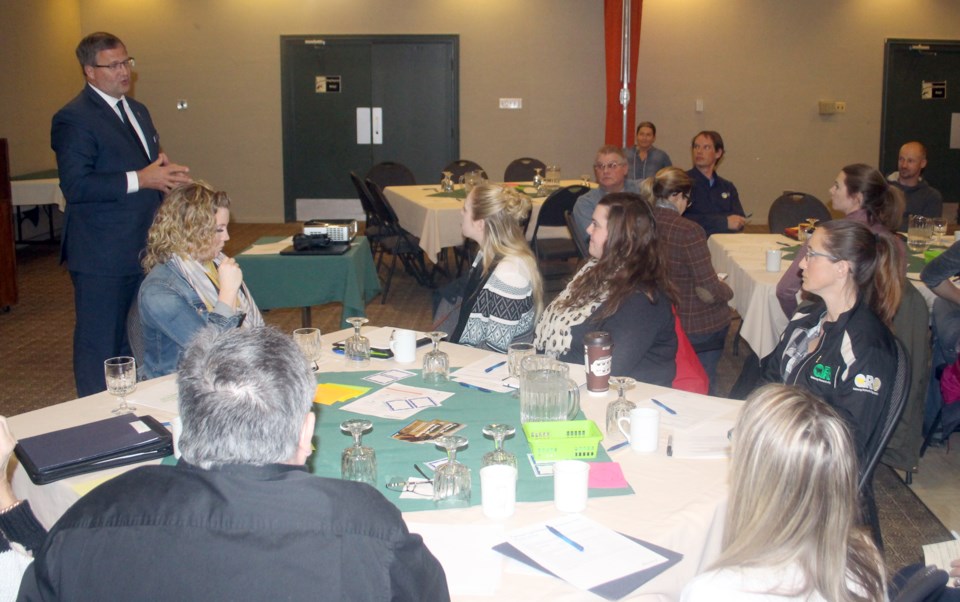BARRHEAD - Maintaining a lack of bias in research, identifying regional priorities and finding ways to better disseminate the information acquired through research while understanding that many producers do not look for information online were some of the points expressed at a Jan. 22 meeting in Barrhead regarding priorities in “farmer-led research.”
Excluding representatives of Alberta Agriculture and Forestry (AF), about 25 people turned out for the discussion forum hosted at the Barrhead Neighbourhood Inn.
This was the fifth of nine such meetings being held across the province to assess the priorities of farmers and ranchers, as well as various agricultural organizations, regarding provincially-funded research. In addition, the province is gathering input through an online survey until Jan. 31. The survey is linked on the front page of AF’s website.
Athabasca-Barrhead-Westlock MLA Glenn van Dijken, who took part in the Jan. 22 session both as an elected representative and a farmer, said the government was carrying out this consultation “to try and understand what the people in the field are seeing, what they’re hearing, what they’re needing.
He added, “This whole process is about doing agriculture, not only the way we do it now, but how we can do it better in the future. Research is a big part in understanding how … we’re able to do this sustainably well into the future.”
In a discussion paper provided to participants, it was noted prior to 2016, the province often provided grant money to external research bodies who in turn used these funds to advance the profitability and competitive of the agriculture industry.
However, that essentially ended following the closure of the Alberta Livestock and Meat Agency (ALMA) in 2016 and the shuttering of the Alberta Crop Industry Development Fund (ACIDF) in 2018.
Instead, AF created the Strategic Research and Development Program (SRDP) and took over management of ALMA’s research projects. Research was also expanded beyond livestock-related projects to crop research.
In 2018-2019, AF provided a total of $9.9 million in research grants, collaborating with marketing boards and commissions. Research has been focused on priorities like managing clubroot and stripe rust, advancing the fertility trait in dairy cattle, increasing water use efficiency and drought tolerance in field peas and increasing precision breeding of wheat.
Alberta is also one of the few provincial governments to maintain internal research capacity in agriculture. AF’s research facilities include the Crop Diversification Centre in Brooks, the Field Crop Development Centre in Lacombe, the Alberta Irrigation and Technology Centre in Lethbridge and the Farm Stewardship Centre, which is also in Lethbridge.
However, the discussion paper notes that researchers have been challenged by a reduction in available funding to conduct research projects.
In 2010, Agriculture and Forestry leveraged more than $11 million per year to complete research projects. In 2018-2019, that amount dropped to $2.6 million.
What was said
At the Barrhead forum, participants were sorted into three groups and given a list of questions to discuss, such as what factors should drive research priorities and whether farmers/ranchers found it easy to access the information needed for their operation.
Answers to the questions were scribbled out on post-it notes. Participants stressed points like that there needs to be better co-ordination of efforts between research organizations and associations, but also that there needs to be consideration toward research being focused on what farmers are producing.
In particular, regional considerations have to be taken into account, and many stressed the need for “unbiased” research that was conducted at arms length, which many participants stressed had worked well in the past.
Noting that many of the participants at his table worked in research and extension, van Dijken said he heard about the need to get information into the hands of producers.
“We’ve got to ensure that (investment of dollars into research) then goes the next step and actually becomes available to agricultural production,” he said.
van Dijken said they discussed the many ways that information gets out to producers and whether or not those methods are effective.
It was noted by many participants that producers don’t necessarily use computers or the Internet to access information.
He also stated that participants recognized the need for more stability in funding, particularly how it connects to the four-year election cycle.
“The associations that are represented here need to have an understanding of stability … and how it’s not just dictated by the four-year election cycle.”
van Dijken said participants at his table talked about solutions to that and how it boiled down to the value of that research.
“The people will recognize it’s always about building a business case on value for money,” he added.



